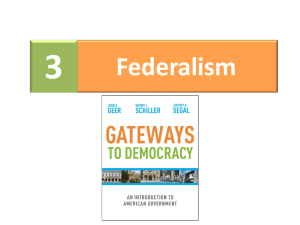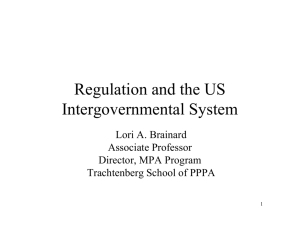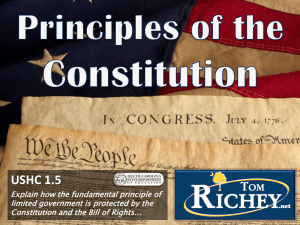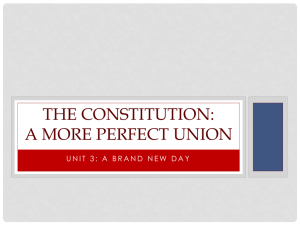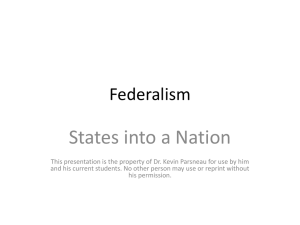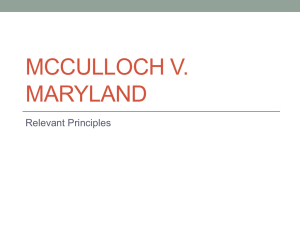Chapter 3-Federalism
advertisement
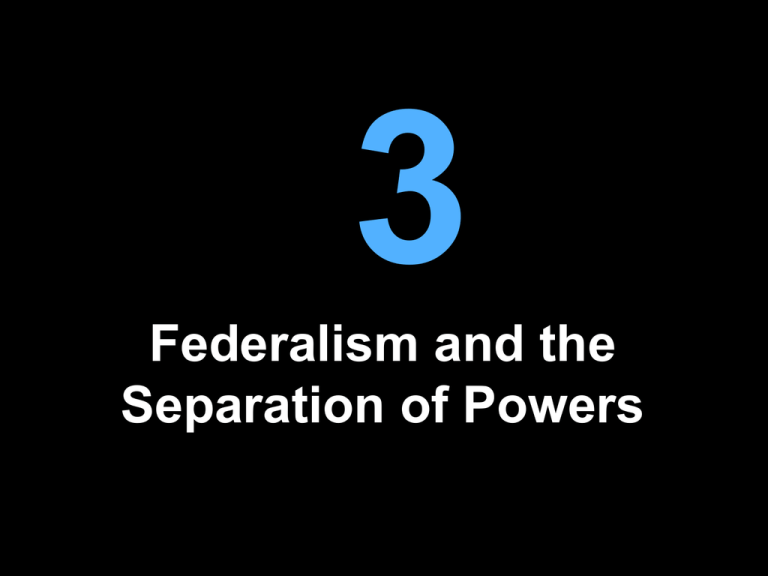
3 Federalism and the Separation of Powers What is Federalism • To understand federalism, we must first understand how a unitary system works. – UK – France • Unitary systems differ in many ways from federal systems and amongst themsevles. Unitary systems • Elections – vote for parties not candidates. – Party that wins the majority of seats in the legislature forms the government. – The leader of this party is the Prime Minister. – Single party government is the norm with single member districts. Unitary systems (cont) • Proportional representation (PR) systems: – Parties get number of seats in legislature proportional to vote totals. • There are usually minimum requirements (thresholds) • Often result in coalition governments as no single party wins a majority of the seats. – Italy, Germany. – Sometimes even minority governments form. Unitary systems (cont) • How does this effect policy formation? – Answer largely depends on electoral system. • Single-party government: – A sort of benevolent dictatorship. – Very few veto players—effective governance. • Multi-party government: – More voices/more interests/tougher CA problem. – Better quality outcomes/more representative. Unitary systems (cont) • How do governments fail? – They lose elections. • Elections can be called at the leisure of the gov’t, but must be called every few years. – The lose the support of parliament • Called a vote of no confidence. • Not common under single-party govt. Federalism • Federalism: – The division of powers and functions between different levels of government. – In the U.S.—the state and federal levels. – Works to limit the power of both by granting sovereignty to each level. • Under the Articles, the states had total sovereignty. • Led many to resist ceding power to national gov’t. Who decides what? • Expressed Powers: – Powers specifically granted to the federal government in the Constitution. • Implied Powers: – Derived from necessary and proper clause. • Reserved Powers: – Derived from 10th amendment. – Powers not granted to the federal are reserved to the states. What are states’ powers • Police power: – The power reserved to the state govt to regulate the health, safety, and morals of its citizens. • Gun laws. • Abortion laws. • Drinking laws. • Concurrent power: – Powers possessed by both state and national • Levy taxes Promoting Unity between states • Full faith and credit clause: – Requires each state to honor the public acts and judicial decisions of other states. – Some legal battles in the near future… • Privileges and Immunities – States can’t discriminate against other states’ residents. – Extradition issues. Two types of federalism: • Dual Federalism – The pre-1930s U.S. system. – Two-layered (national and state). – States and local did most of the governing. – Federal gov’t exercised limited power. THE FEDERAL SYSTEM: SPECIALIZATION OF GOVERNMENTAL FUNCTIONS IN THE TRADITIONAL SYSTEM, 1789–1937 Two distinct levels, but… • Article 1, section 8: – “Necessary and proper” • Also called the Elastic Clause – Commerce Clause • Congress can “regulate commerce with foreign nations, and among the Several States, and with the Indian Tribes” • Has been used to defend National superiority/encroachment on States McCulloch v Maryland (1819) • Can Congress charter a bank? • It does and it’s unpopular • Maryland levies a 2% tax. • James McCulloch (bank agent) refuses to pay. McCulloch v Maryland • It goes to Supreme Court. • Two main questions: – Can Congress charter a bank. – Can a State tax Federal entity? Answers… • (1) Yes. Under the necessary and proper clause, this is a Constitutional exercise of federal power. • (2) No. The 10th Amendment reserves to the states only powers not delegated to the federal government the power to tax. Also, the Supremacy clause kicks in here. Gibbons v Ogden • NY state legislature gives Ogden steamboat monopoly. • NJ steamboat operator, Gibbons, tries to steal some of the business. • Ogden is upset— pressures NY to act. • Gibbons hires Webster and goes to SC. Gibbons v Ogden (1824) • The 2 big questions: • Does the Constitution permit the federal govt to regulate navigation? • Is the NY monopoly Constitutional under the 10th amendment or does this violate the Commerce Clause? Gibbons v Ogden-the answers • Yes. Commerce is more than just buying and selling while the power to regulate commerce within a state belongs to the state, commerce among not stop at the border. • No. The NY monopoly is unconstitutional because the Supremacy Clause gives the federal govt’s laws precedent here despite the 10th Amendment. (but only because the fed gov’t chose to regulate). Nationalization • Bottom line: Power is shifting from the states to the federal gov’t. • The 10th Amendment usually loses at the Supreme Court level. • It’s kind of like the Ohio State of Amendments. FDR and the New Deal • In the 1930’s President Roosevelt expanded the power and scope of the federal gov’t to unprecedented levels. • Gave rise to fierce battles in the court. – At first, FDR lost. – By the late 1930s, the court had changed its tune and began to support expansion of the federal gov’t. New Deal • Roosevelt’s New Deal was a comprehensive set of economic regulations and relief programs (massive in size and scope) intended to fight the Great Depression. • To justify its unprecedented intervention in the economy, FDR invoked the commerce clause. LBJ and the Great Society • Elected in 1964, Lyndon Johnson and his Democratic Congress launched a War on Poverty – part of a Great Society agenda. • Passed more than 100 new categorical grant programs. Spent over $5 billion 1964-65. • Grants supplemented state programs/national goals. • Traditional state and local responsibilities became federal ones. The other type of federalism • Cooperative Federalism: – Post New-Deal system in which grants-in-aid have been used strategically to ‘encourage’ states and localities (without commanding them) to pursue nationally defined goals. Also known as intergovernmental cooperation. – Also known as… Also known as… Bribery Cooperative Federalism • Grants-in-aid – Carrots, or ‘bribes’ whereby Congress gives money to states with conditions that the money be spent for a specific purpose. • No Child Left Behind • Have become much more common over time. THE HISTORICAL TREND OF FEDERAL GRANTS-IN-AID From Cooperative to Regulated • Federal gov’t has expanded from economic to social policies. – Intervention on behalf of individual rights and liberties. • Federal gov’t provides grants-in-aid but set conditions. – Setting national standards. • American with Disabilities Act From carrots to sticks • Unfunded mandates – National standards imposed on state/local governments by the federal gov’t without funding. • National elections. • Indigent legal representation. • Lots of programs/standards. – Unfunded Mandates Reform Act (1995) • Requires fed to pay for programs over $50 million. New Federalism • Battles continue between states and federal gov’t. – Nixon and Reagan pushed to give more power back to the states. – Rallying cry for many Republicans starting in the 1980s and continuing today. New Federalism: Block Grants • Another alternative to categorical grants: block grants. • Like categorical grants, funds are appropriated to achieve a particular policy goal with specific administrative procedures. • Policy targets are only generally stated. • Fewer strings are attached. FOUR VIEWS OF FEDERALISM American Government, 12th Edition Copyright © 2012 W.W. Norton & Company Separation of Powers • “There can be no liberty where the legislative and executive powers are united in the same person…” • Checks and Balances – Mechanisms through which each branch of gov’t is able to participate in and influence the activities of the other branches. CHECKS AND BALANCES Legislative Supremecy • Congress is the most important branch. • Given that Congress would likely dominate other branches – Madison recognized concerns in Federalist 51 – Congress split into two houses. • Further separation of powers limits ability of Congress to dominate. • Divided gov’t further constrains power. Executive-Legislative relations • Post-Watergate – Congress put lots of limits on the President. • Reagan era – Reagan played nice with Congress and won back some powers • But a spot of bother over illegally funding an illegal war. • Clinton got impeached. • W “the Decider” fought over exec privilege. – Confidential communications not to be shared with Congress • Obama and the current Congress—at each other’s throats. Supreme Court and SOP • Judicial Review – Idea that the courts can decide on the Constitutionality of acts of other branches. – Periods where the court has been more/less active, but judicial review is relatively uncommon. • Generally more pro-President. – Some exceptions (Nixon and Clinton, for example) A NEW FEDERAL SYSTEM? THE CASE RECORD, 1995–2006 • More judicial activism lately. • Less deference to Congress. • A push back to states’ rights.

